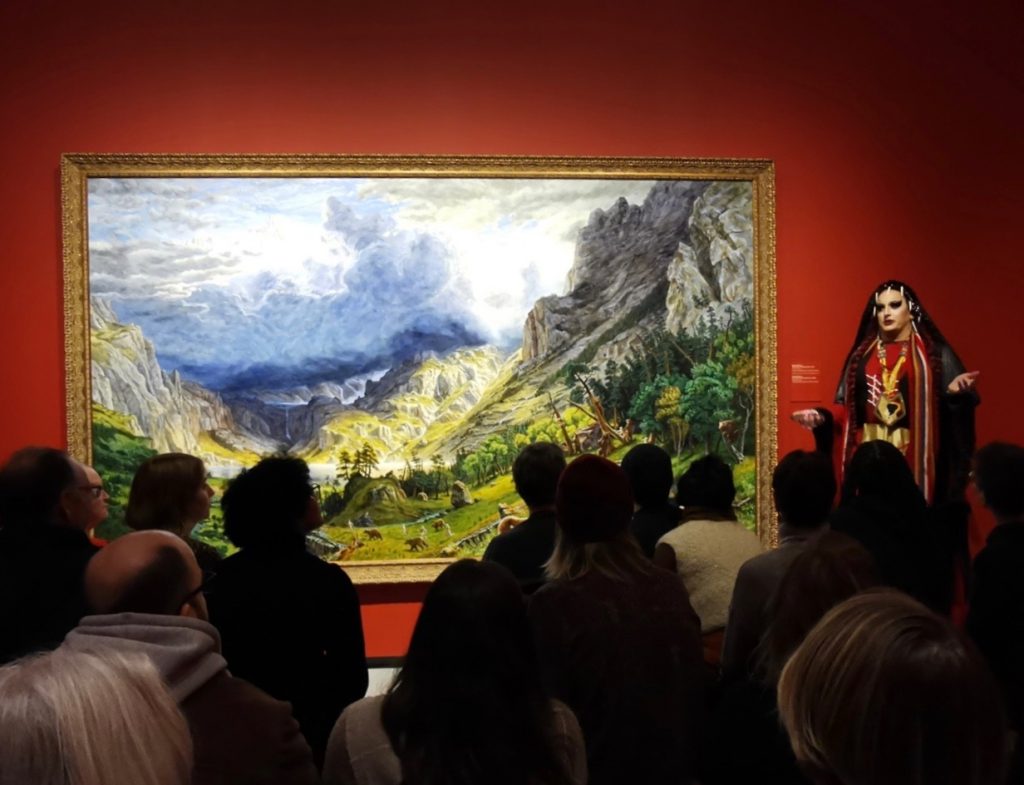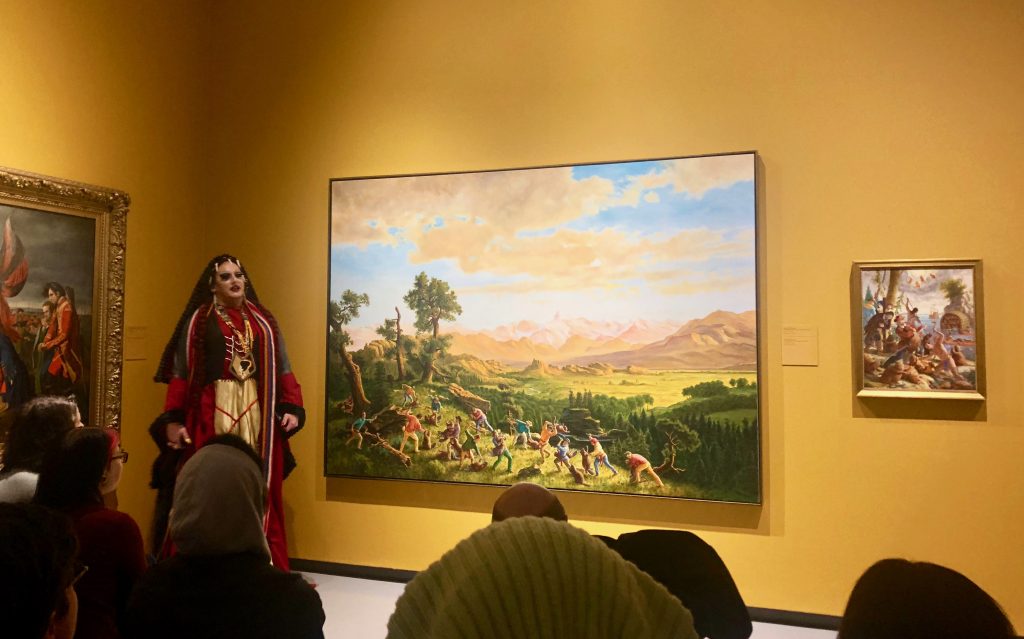For more information on this exhibit and event, visit the WAG website.

“It was inspiring to view an Indigenous two-spirit person’s work on display in a mainstream gallery with his art being as critical of colonization as it is. Monkman says that this is part of his intention; not to decolonize, as the gallery is colonial in its roots, but to de-centre the point of view offered to visitors. Having a local Indigenous two-spirit drag queen, Prairie Sky, lead our discussion was also a fantastic way to continue that critical analysis as she shared with us some of her personal history and why that conflicts with some of the messages in the artwork. It is always a great reminder to every attendee that Indigenous histories aren’t identical, but are a complicated and complex mix of perspectives and experiences.” — Chris Eastman
“The thing that really struck me about local drag queen Prairie Sky’s tour of Kent Monkman’s exhibition was her conversational approach. Right at the beginning, Prairie foregrounded the fact that she is not an art historian, yet she lead a deeply intelligent and incredibly fun conversation engaged around Monkman’s work. Gallery visitors asked questions; others shared bits of knowledge and personal experience; people nervously giggled as someone explained bear culture in the gay masculine world; Prairie shared her own personal relationship to some of Monkman’s work highlighting the differences in her relation to the fur trade from Monkman’s. Nobody seemed to be expected to have a complete or perfect response or interpretation to the work. What emerged out of this evening was a conversation rather than a tour. This felt like a very unique moment of contact between queer and specifically drag communities and the fine arts world.” — Misha Falk
“As Prairie Sky led us through conversations about her own lived and familial experiences of the fur trade, Miss Chief’s power, and the incredible detail of Kent Monkman’s work, I became extra aware of the gallery space surrounding us. Loud laughter, queerness, and seldom moments of total silence occupied the gallery. Prairie Sky’s knowledge, wit, and kindness transformed the gallery space from a passive place of viewing into an active and present discussion – leading to moments of meaningful interpretation and reinterpretation of Shame and Prejudice.” — Dallas Cant
“I found myself transfixed by the large-scale paintings in Kent Monkman’s exhibit, Shame and Prejudice. I would first take in the beauty of the backdrop, often a vast and picturesque landscape, before slowly being pulled into the narrative of the painting as my gaze shifted to its subjects. Each work of art was flush with detail and nuance, inviting lengthy contemplation and the search for the elusive yet ever-present Miss Chief Eagle Testickle. Monkman’s ability to combine breathtaking artistic skill with political commentary through allegory and a playful sense of humour is powerful and thought-provoking.” — Thiané Diop

“I first went into the Kent Monkman exhibit cold. I have only ever heard of him and might have briefly glanced at his works once or twice in a textbook. But when I saw “The Massacre of the Innocent,” the first painting up in the gallery, I was awed by the size of the painting. It depicts lush green land and high rolling clouds—scenery that reminded me of those western “manifest destiny” paintings that were all about western expansion and “progress.” The size and beauty could almost swallow me whole, but the real focus of the painting is the group of white settlers murdering beavers with their guns. This brutal scene reminding me that this Canadian “progress” meant forcibly and violently taking away this vast expanse of land and resources away from Indigenous peoples.” — Mika Castro
“The Kent Monkman exhibit was nothing if not political, and that’s what makes it exciting. It reframes a history of culture mired in colonial exploitation and posits critical questions, without removing that colonial history from its context. More than just expressing a social commentary, Monkman recreates a national narrative, using a personal perspective to capture and awe his audience without having to spell it out for them. Almost everything in Monkman’s work can be interpreted and explored as cheeky tidbits on his subject matter, extending a good laugh while offering his seasoned talent in the fine arts to ask the critical questions. I can honestly say that the exhibit is one for history.” — Amber Ali
To read more reflections on exhibitions from members of the research team, visit the main SnapThoughts page.
